
2017 marks the tenth anniversary of me exploring Los Angeles for my online series, California Fool’s Gold. For the occasion, I’ve turned to fellow explorers to see where they’d want to go and published my accounts on my newer series, Urban Rambles. My friend Machiko Yasuda and I recently explored Mid-City but she suggested another ramble, which sounded good to me. Her first suggestion was Leimert Park — a South Los Angeles neighborhood which I’ve always quite liked and which I encourage people to explore — but one which I several years ago, after crossing paths at a Metro bus, assured rapper Self Jupiter that I’d explore with him as my local guide. Machiko’s second suggestion was the malls of Koreatown which I thought was a fantastic idea, even if I can’t exactly articulate why.
I hated malls as a kid — especially the Columbia Mall — I suppose in large part because that’s where the kids that I disliked (and who disliked me) preferred to spend their free time. Also, aside from the arcade and cinema, it was hard for me to imagine anything more boring than drinking Orange Julius and walking from boring boutique to boring boutique. I even claimed to have an undiagnosed disorder which caused my joints to fail upon entering any indoor shopping center.
Out of contrarianism, I championed my hometown’s older, struggling malls, namely the (now demolished) Biscayne Mall and the Parkade Plaza — which by the late 1980s counted on tenants like insurance offices, a model train shop, a Montgomery Ward, and a DMV office to keep the lights on. Honestly, both of those malls were lame — but unlike the Columbia Mall, no one mistakenly thought that they were cool or glamorous.
Nowadays it seems like no mall is cool (unless you’re in the Philippines) and the sorts of people to whom they formerly appealed now prefer the faux-downtowns of the Grove, the Americana at Brand at Glendale, Atlantic Times Square, and even, in the view of some, DTLA. “DTLA,” although it stands for “Downtown Los Angeles,” isn’t exactly the same thing, in the way that “LA” isn’t the same place as “Los Angeles.” “K-Town” and “Koreatown” are though, I think.
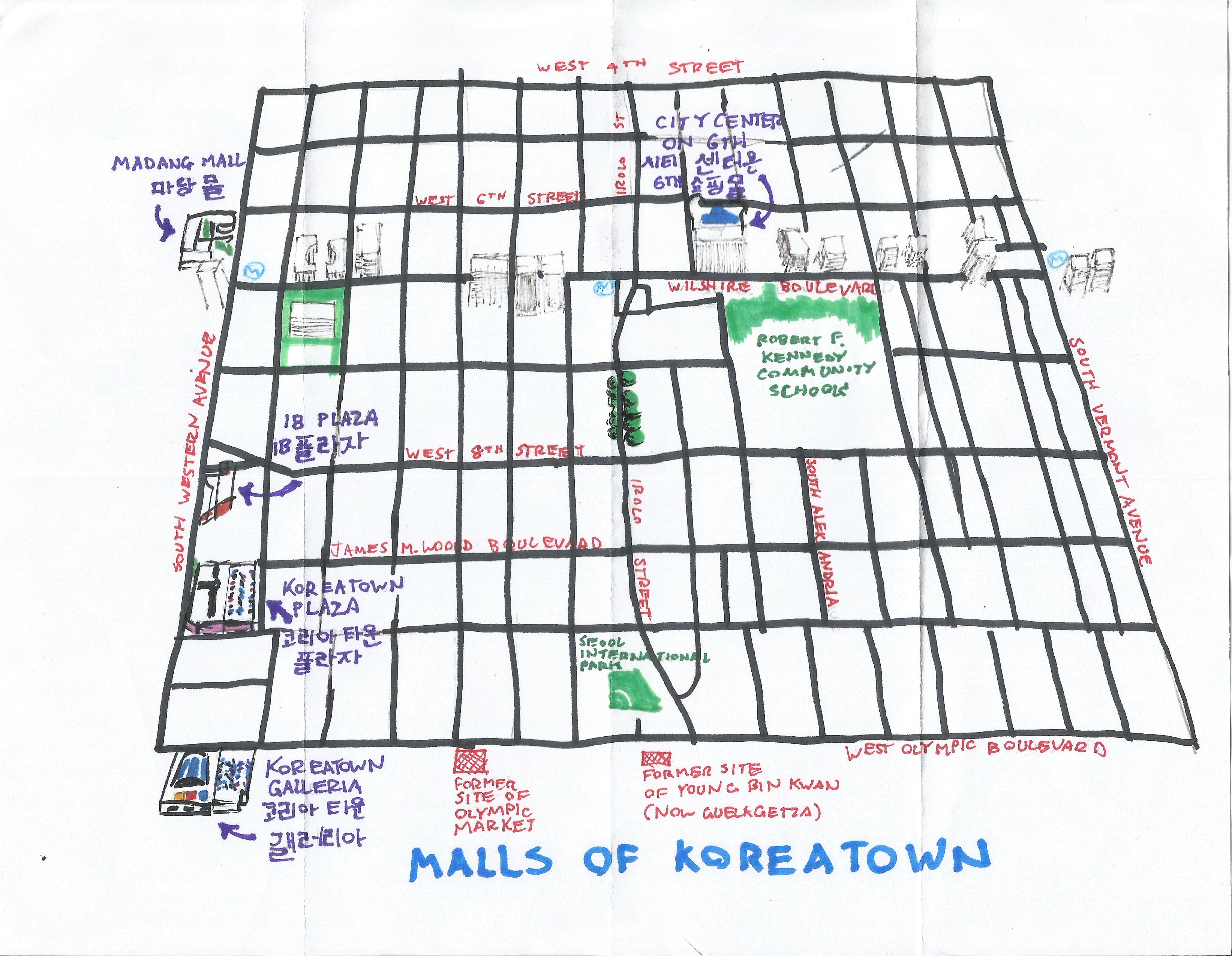
I didn’t really get a sense of how malls are regarded on my recent vacation to Korea. To be honest, it’s not something that crossed my mind, although when I sort through memories I can point to a couple which result from experiences within various malls of Seoul and Busan. In both cities, malls seemed not to occupy a distinct space in the vast, urban retail landscape. More memorable are the businesses which often occupy the bottom floors of gleaming mixed-use highrises, the subway stations which each host a variety of retail (and non-retail) spaces, and even the sidewalk vendors, such as the one in Jongno from whom I procured the cat-themed handkerchief I used to mop the sweat from my brow as I waited for Machiko at the subway station.
We met up at Wilshire/Vermont Station, a curiously dumpy subway stop on the Purple Line. None of the downscale, low rent shops appealed to anything in me so I hung out in the courtyard, reading a book and watching homeless people change position to avoid the glare of the son. A man tried unsuccessfully to score drugs and a young woman tried, unsuccessfully, to get me to purchase some tickets for her church’s raffle. There are planters, which instead of nourishing actual plants, are topped with astroturf and the inescapable smell of sun-dried urine let to me assuming that they serve as giant urinals for both dogs and humans.
Cater-corner the train station is the Wilshire Galleria, the name of which at least suggests a mall, but which was actually built in 1939 as a department store for the long-defunct chain, I. Magnin. The boxy but attractive Art Deco structure was designed by the great Myron Hunt. In 1992, two years after I. Magnin departed, it reopened as the Wilshire Galleria. We peeked through the front doors at the beautiful interior, currently undergoing renovation as its owners, the Harridge Group, work to transform the property into a mixed-use space.
CITY CENTER ON 6th – 시티 센터 온 6th



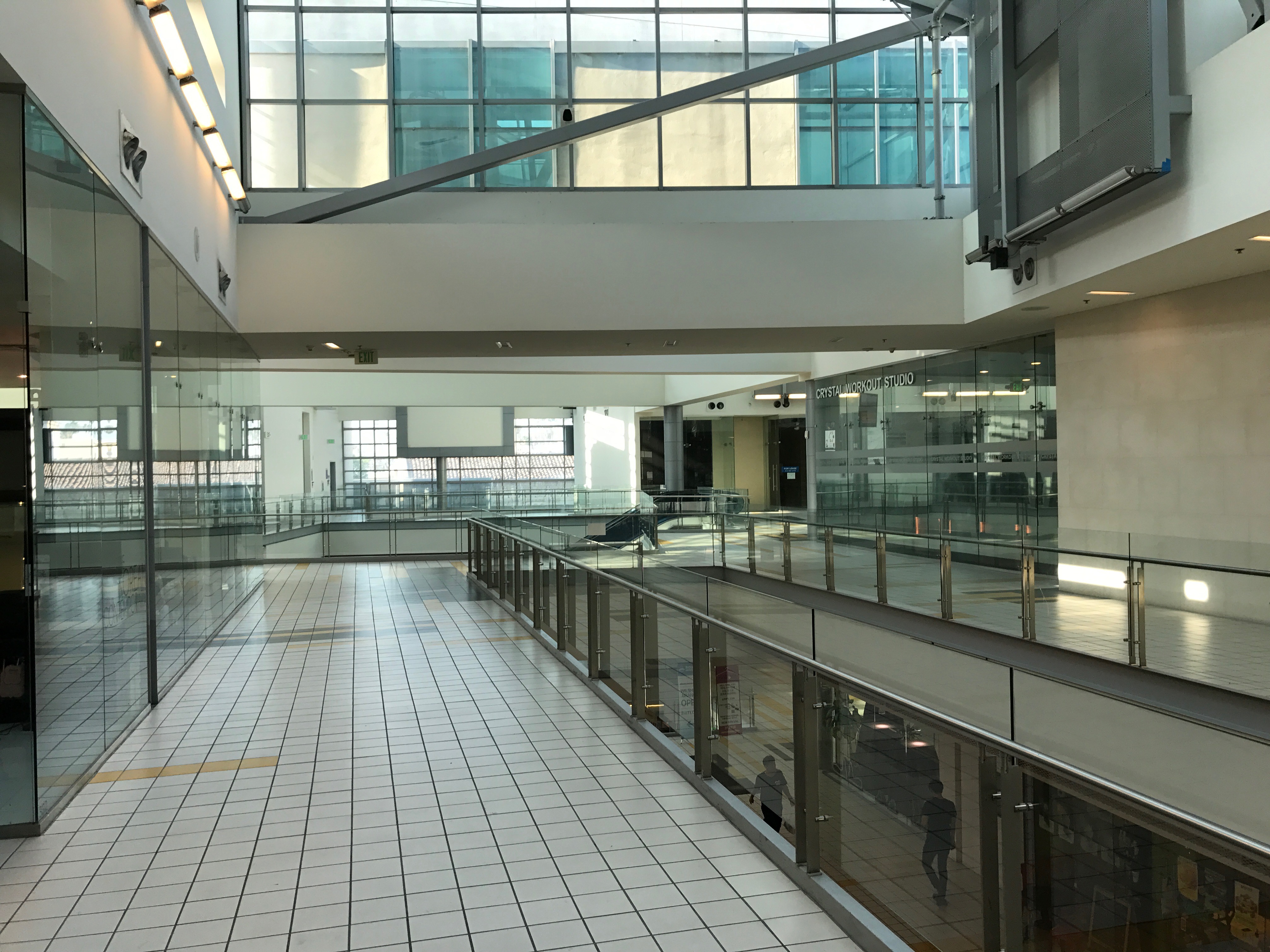
The first mall we visited was City Center on 6th. According to the County Assessor, the mall opened in 2007, which surprises me, because aesthetically, it seems as much as the Wilshire Galleria to be the product of a long past era. Nevertheless, there are Yelpers who in their reviews of a mall describe the design as incredible and beautiful.
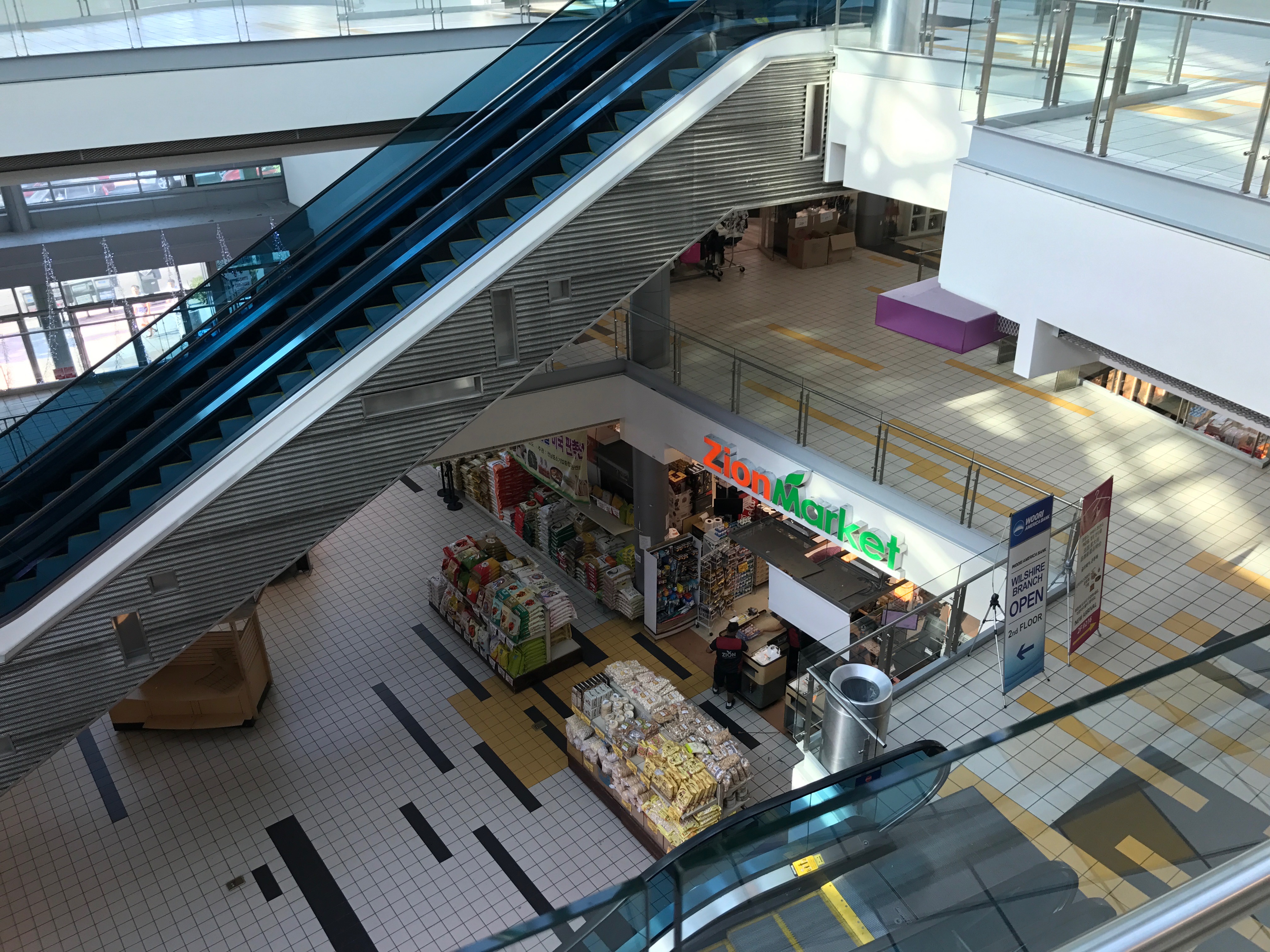

Like the Wilshire Galleria, the City Center on 6th could also likely benefit from conversion to a mixed-use building. As you climb the stairs or ascend the escalator, the vacancies increase and the top floor is almost entirely empty. I honestly think it would be a decent place to live. Consider — it’s far from any freeways, it’s a walkable neighborhood, and there are great restaurants, decent bars, a music venue, (small) parks, and a library nearby. Additionally, there’s a CoCo Ichibanya on the ground floor — and (as with many Korean malls) — it’s anchored by a market, in this case, Zion Market.
MADANG MALL – 마당몰
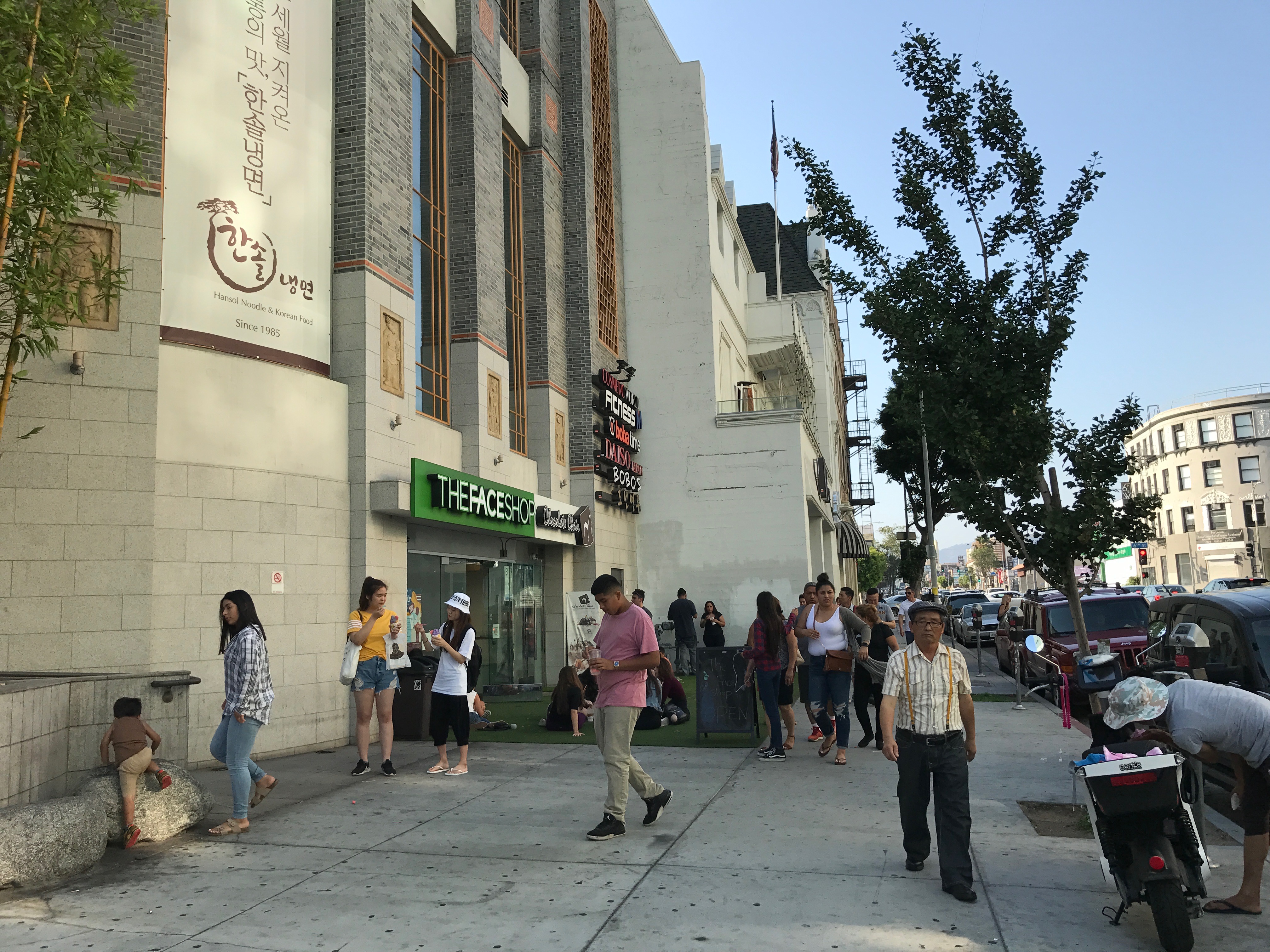
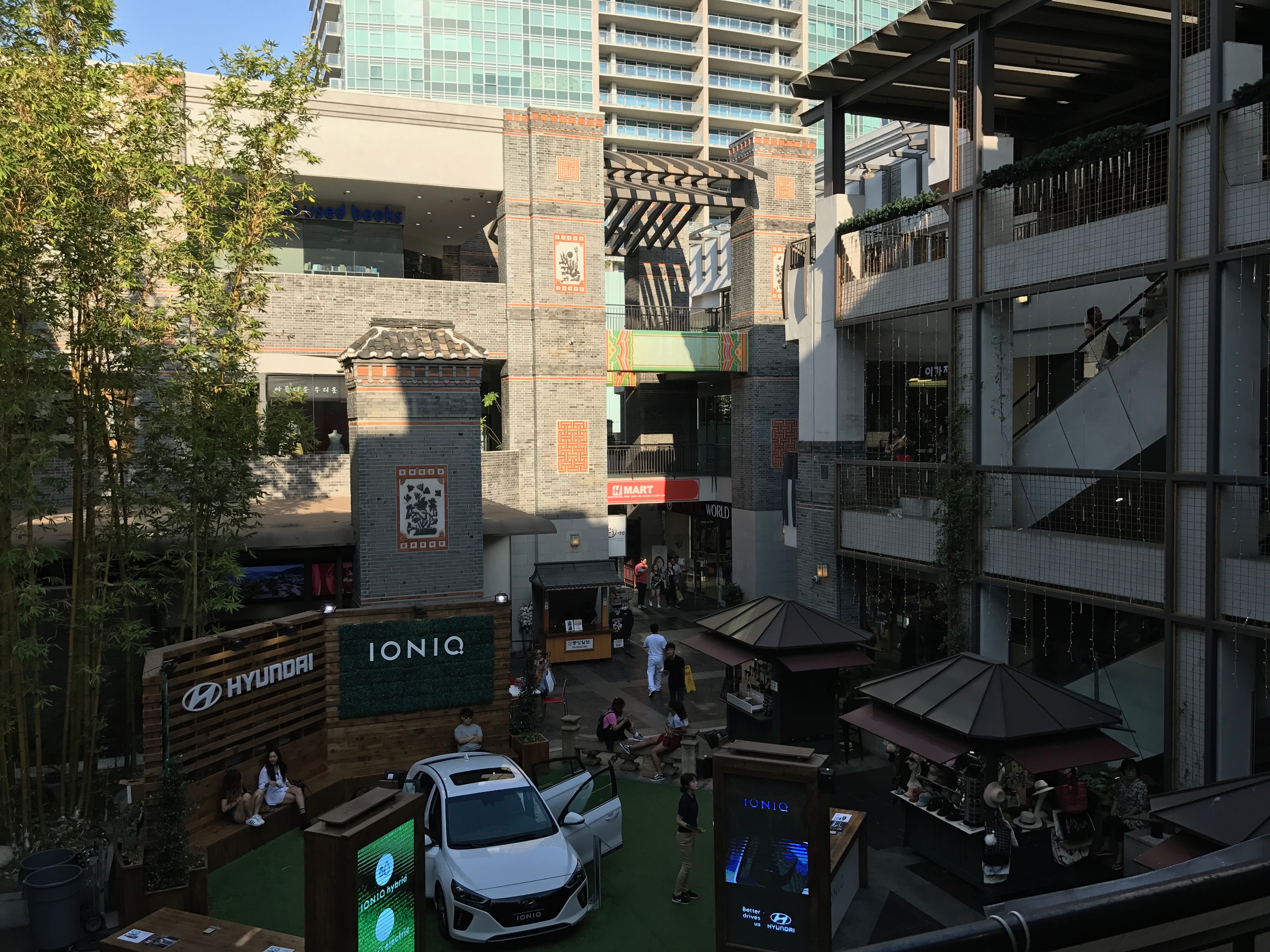
Technically, I suppose, Madang Mall (which opened in 2010) didn’t meet our shared definition of a mall, because it’s not really an indoor mall but rather a three story shopping center oriented around an open courtyard — perhaps inspired by the design of Korea’s traditional homes, hanoks. As far as I know, its name doesn’t appear anywhere on any signage and Machiko and I both in planning our ramble referred to it as “the CGV mall,” after the Korean cinema chain. Online, the shopping center is referred to by several names including Madang Mall, Madang Plaza Shopping Mall, MaDang, Madang Courtyard, Madang Plaza, and 마당몰, which literally translates to “yard mall,” “마당 (madang)” being Korean for yard… and rendering name variations like Madang Courtyard a bit silly. CGV, I also found out, stands for “Cultural, Great, and Vital” — which no one probably needs to know.
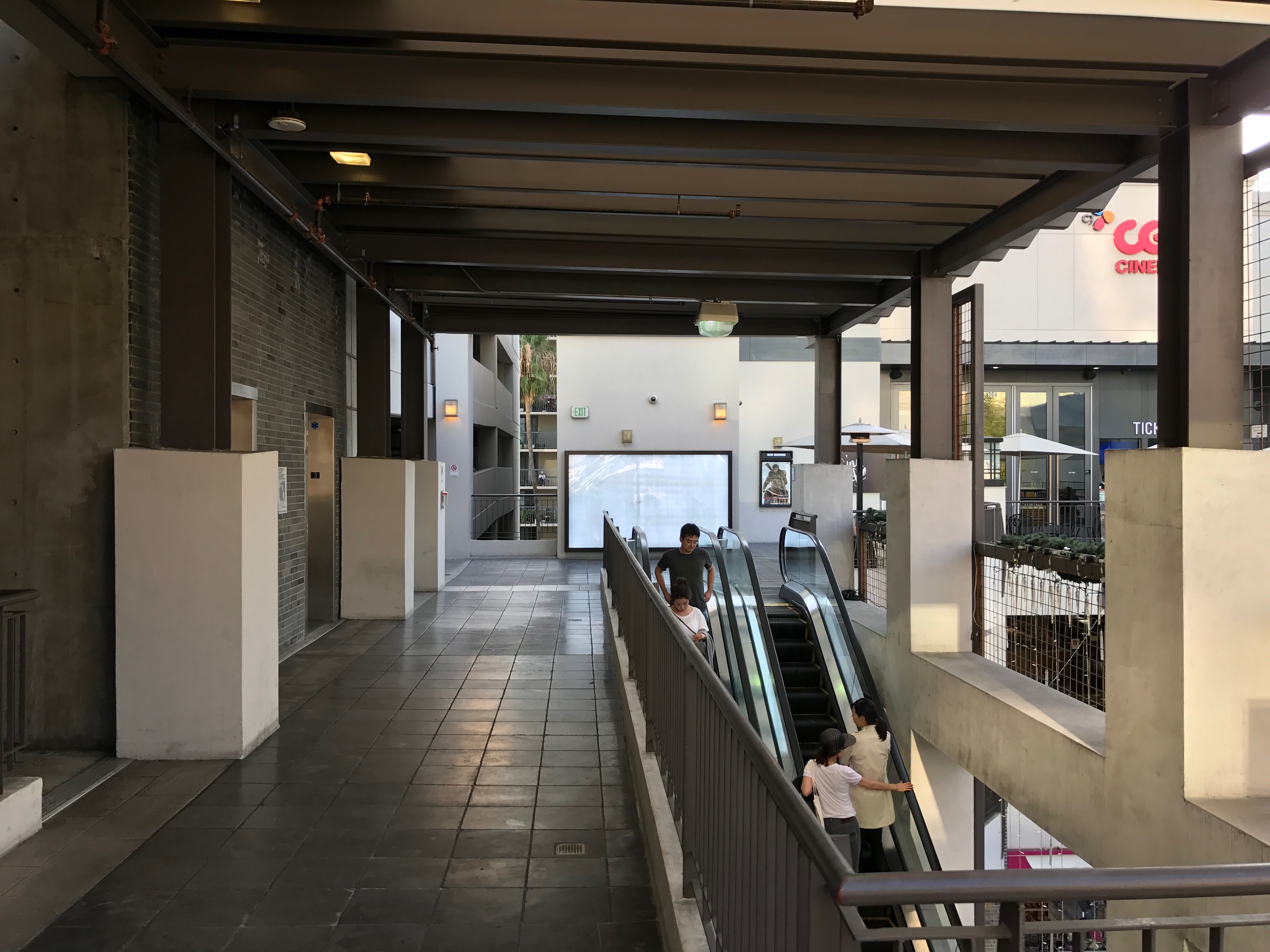
At Madang, I thought we might run into Una, who’d earlier gone to Sul & Beans with a co-worker of hers, but by the time we arrived they’d relocated nearby to Beer Belly. Both Sul & Beans and SomiSomi are perpetually busy — although there was a curious break in the otherwise permanent line at the latter so Machiko seized the opportunity to order a black sesame soft serve with strawberries.
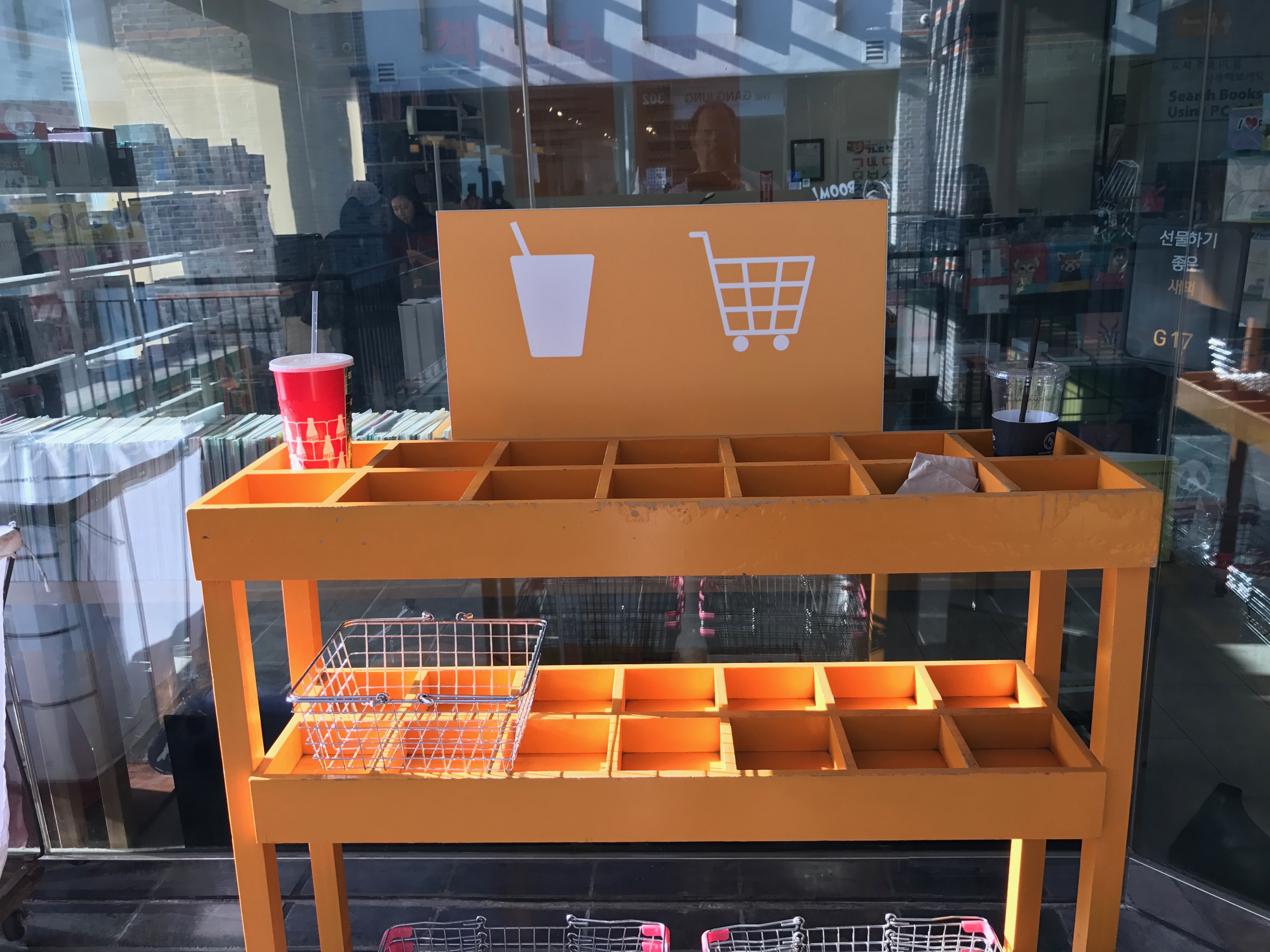
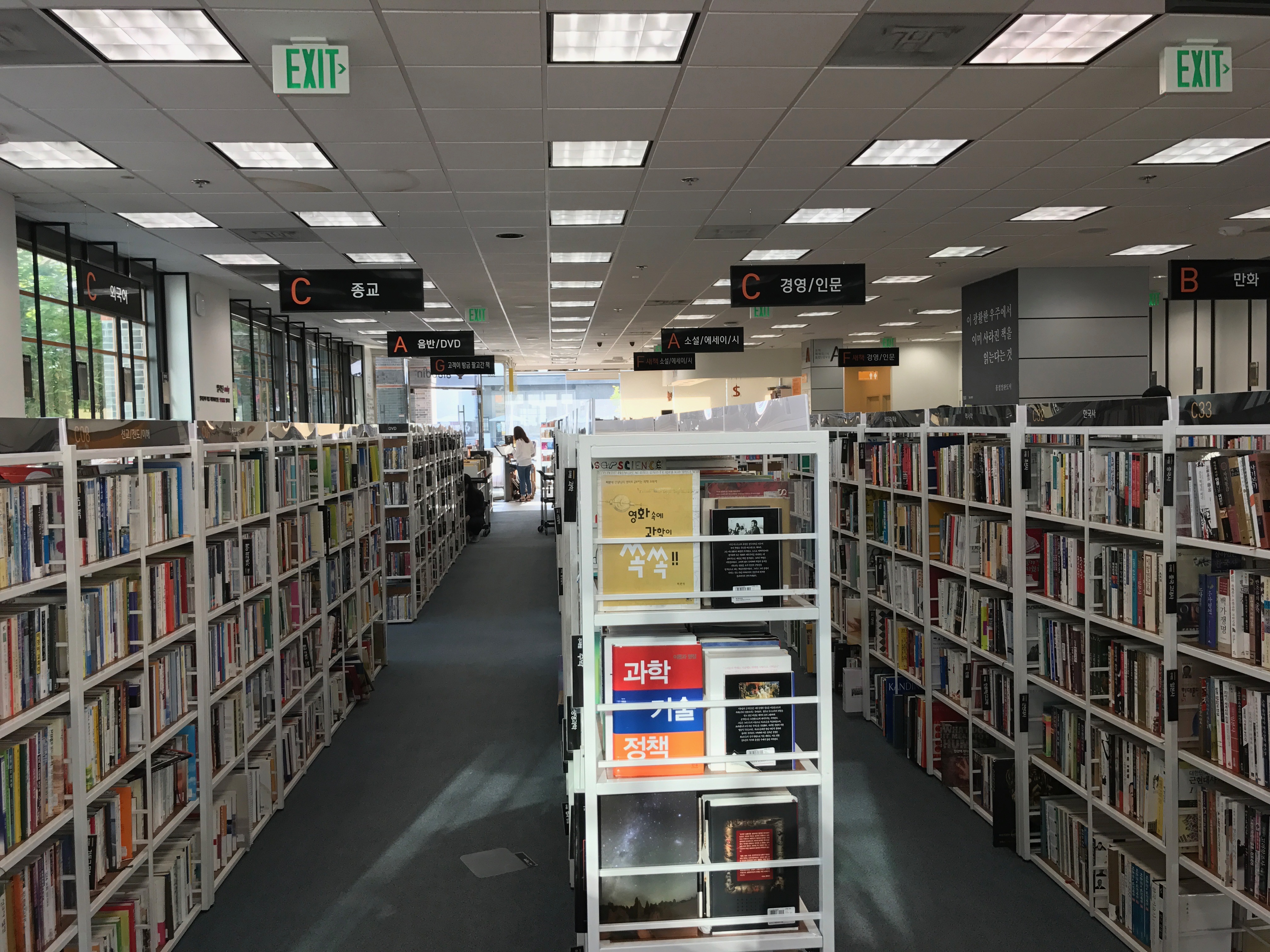
Afterward we headed up to 알라딘 서점 Aladdin Used Books, where we took comfort in the deep hum and chill of their air-condition as we browsed books and CDs. They had an album by Linus’ Blanket — but it was Semester, their six song 2003 debut, and I’d have preferred something more recent.
IB PLAZA – IB 플라자
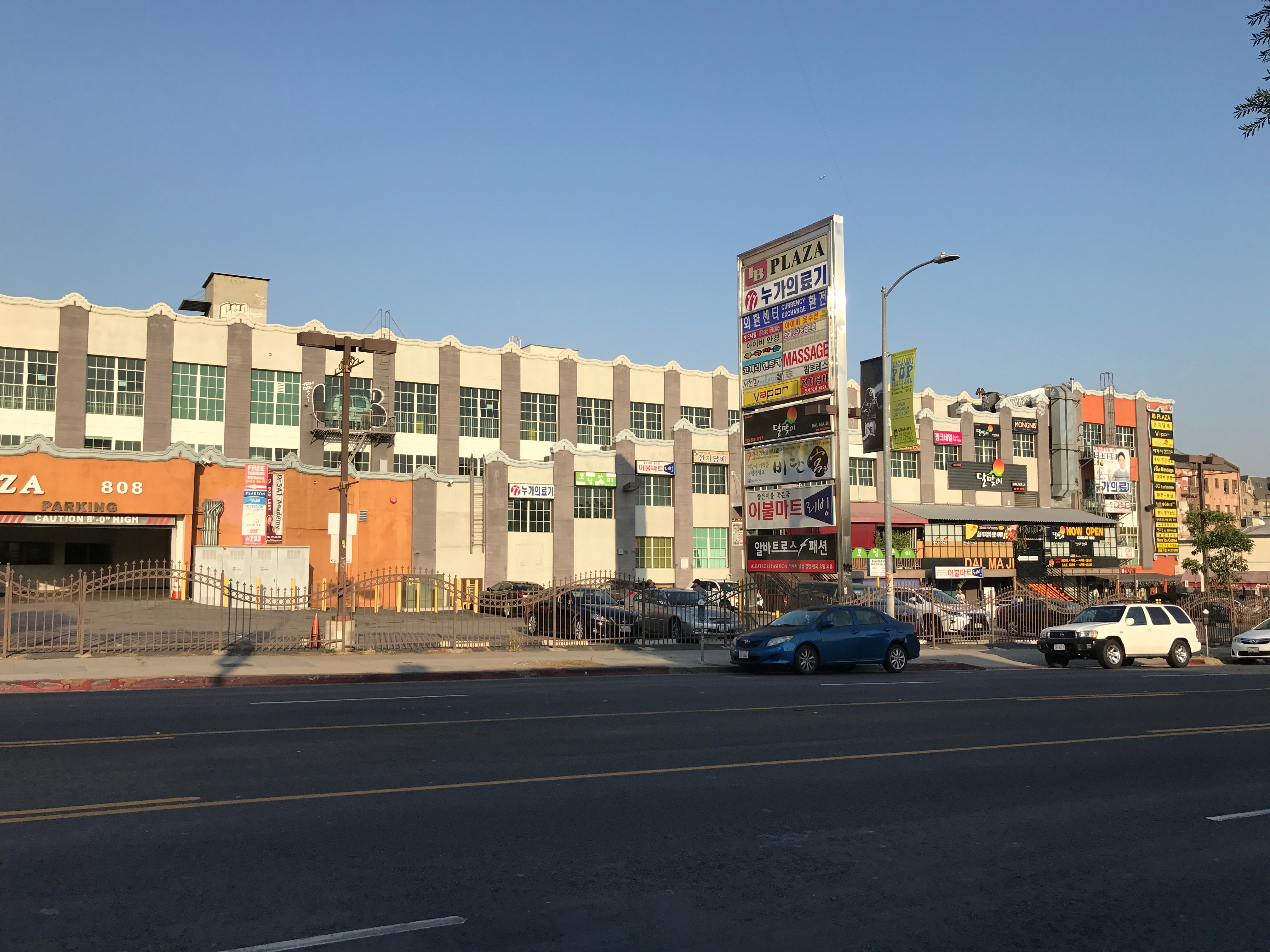
IB Plaza has always both intrigued and confounded me. The kaleidoscope of weird angles, the appearance of cars behind upper floor windows, and proliferation of signs in hangul have all attracted my attention in the past, but nothing has drawn my eye toward an entrance other than one apparently for automobiles. What does “IB” stand for, for that matter? A website called Visit Korea Town might be expected to adopt a boosterish tone but instead describes IB Plaza as a “large rundown shopping structure.” As we stood across the street pondering and admiring, several people were witnessed entering through what appeared to be two entrances, and so we crossed the street.

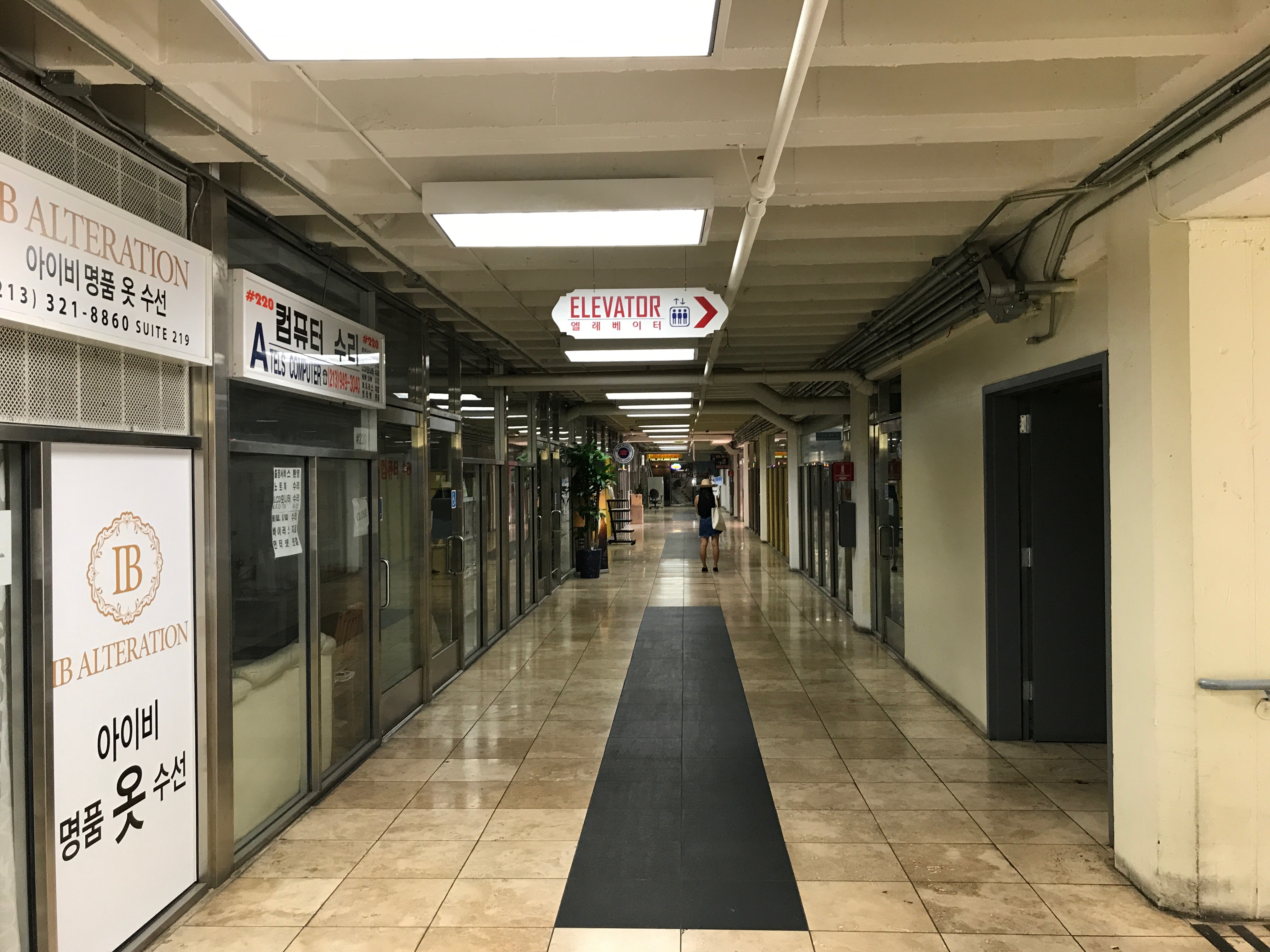
Built in 1931, IB Plaza’s construction pre-dates Koreatown, even though it feels thoroughly Koreanized now. Back then, the Korean population of Los Angeles was mostly centered along Jefferson Boulevard in South Los Angeles’s historic West Adams district. The Korean population was still sufficiently present there as late as 1965 when Francis Lewe opened the city’s first Korean restaurant, Korea House, at 2731 West ]efferson. IB Plaza was apparently built to house an automobile sales business. Today it contains several businesses and it is, despite appearances, essentially an indoor mall — although it feels a bit like the aforementioned sorts of shops frequently encountered by subway riders in Korea. It might not be especially pretty, at least in its current state, but what it lacks in beauty it more than makes up for with gritty charm and a strange air of mystery. How could anyone not love a retail space that at every dead end or narrow hallway makes patrons feel like trespassers?


Sadly, IB Plaza might not be long for this world, despite the presence of tenants, its unique designs and arguably historic character. In 2016 its current owners, Western Plaza Capital Holding, filed plans to redevelop the property as a large mixed-use complex with 96 residences and 148 hotel rooms. Although Los Angeles is in dire need of housing — and while it’s hard to hate mixed-use developments — shouldn’t we preserve weird spaces like IB Plaza until we’ve gotten rid every last parking lot? And when that blessed day comes, perhaps we’ll be able to move weird, creepy malls to outer suburbs like Lancaster, Palmdale, and Santa Clarita, where interesting structures are fewer and farther between. If we can move a big rock to LACMA, and a shuttle to the California Science Center, then moving a mall should be a walk in the park.
KOREATOWN PLAZA – 코리아 타운 플라자

Our next stop was Koreatown Plaza, the most traditional mall of Koreatown, in my view, and the oldest built in the Koreatown era, built in 1987. The mall’s website exhorts visitors to “Experience the fun, meet the happiness at KTP.” It was here that I ventured back in 1998, when I first visited Los Angeles. Staying in Chino and almost daily commuting to see friends in Santa Monica, I passed by Koreatown twice a day. My friends who played tourguide were both natives of Los Angeles and between them, they took me to see the sites of Chinatown, The Grove, The Hollywood Walk of Fame, Little Ethiopia, Little Tokyo, the Miracle Mile, the beaches of Malibu, the Sunset Strip, and Venice. When I expressed interest in Koreatown, both assured me that there was nothing worth visiting there. This was fifteen years before Anthony Bourdain “discovered” Koreatown on his television program, Parts Unknown, mind you. Needless to say, on my first day that I had to myself, I headed straight there. Once arrived I spent most of the day at KTP, people watching, window shopping, and “meeting the happiness.” I even bought a souvenir pendant of the taegeuk which I attached to the zipper of my jacket.

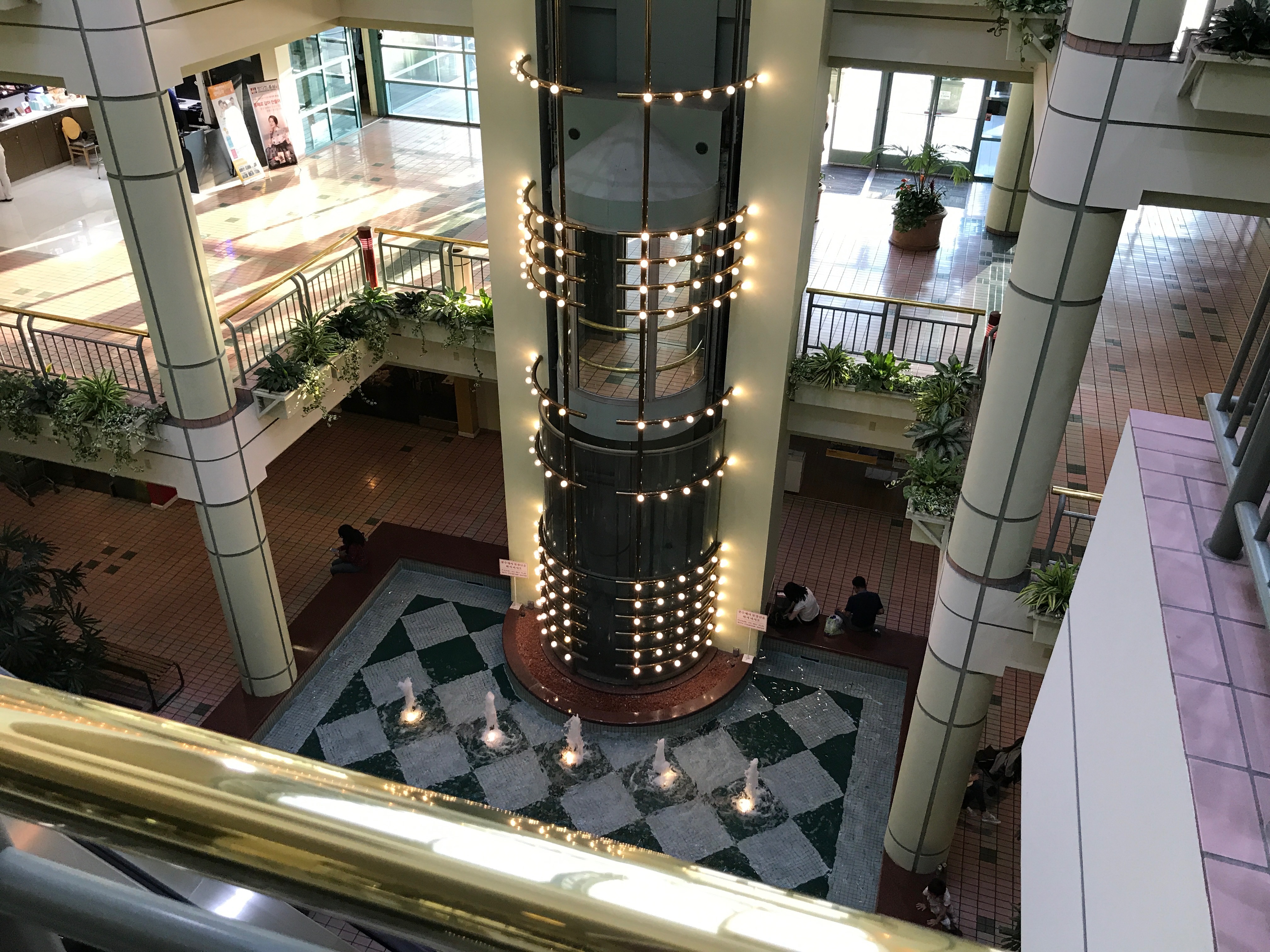
On my first visit to the plaza I naturally ate in the food court, described by its neon signage as “International.” Technically the “international” designation is true although, aside from the perennial phở joint, most of the options remain Korean. Back in Iowa, where I lived at the time, I’d rented an apartment near a Japanese & Korean restaurant and market, Aeoshe, which made no mention its Korean-ness. Being vegetarian, I’d only eaten the vegetable yakisoba.
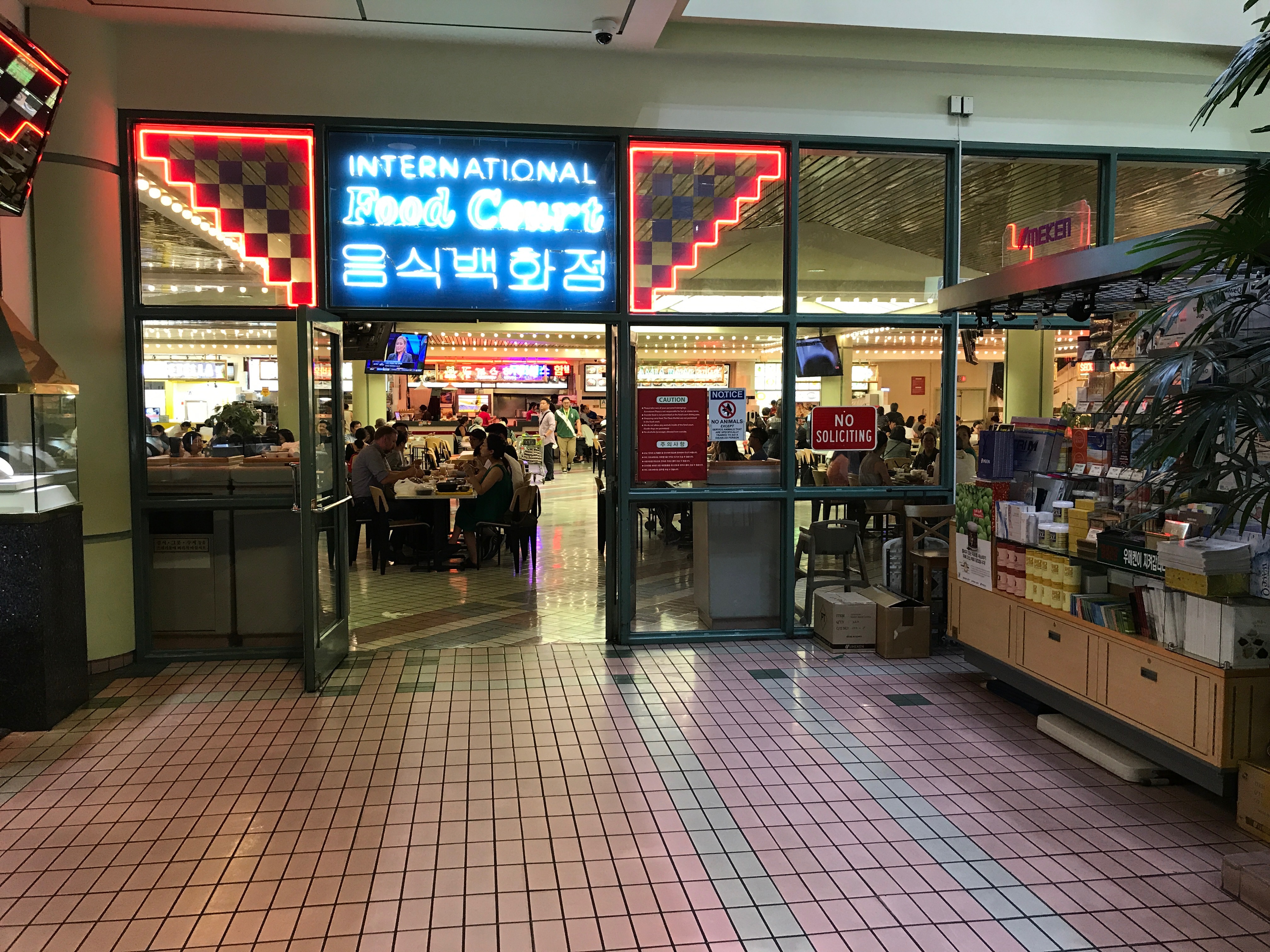
So it was in the international food court of KTP that I consumed my first ever Korean dish, jjajangmyeon — unaware of its debatable Korean-ness until more recently, when I went there with a visiting Korean friend and her son, who knows me as “Uncle Pepperoni” (kind of a long story), and she casually referred jjajangmyeon as Chinese — not Korean Chinese nor even Chinese-influenced. On examination, jjajangmyeon does, I suppose, resemble the zhájiàngmiàn of China. On the other hand, Chinese-American academic Yong Chen (an associate history professor at the University of California, Irvine) argues that the dish is “thoroughly Korean.”
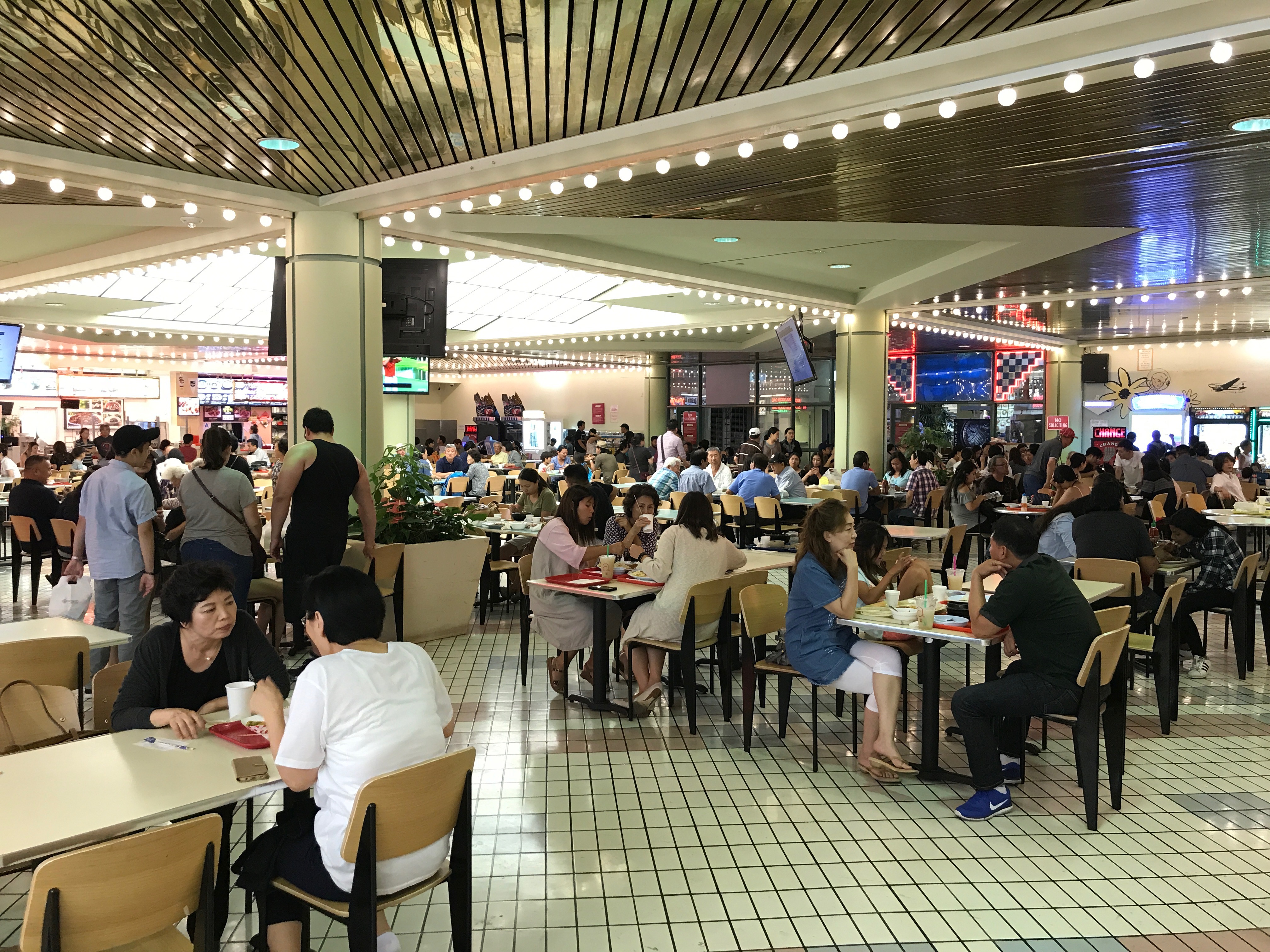
KOREATOWN GALLERIA – 코리아타운 갤러리아
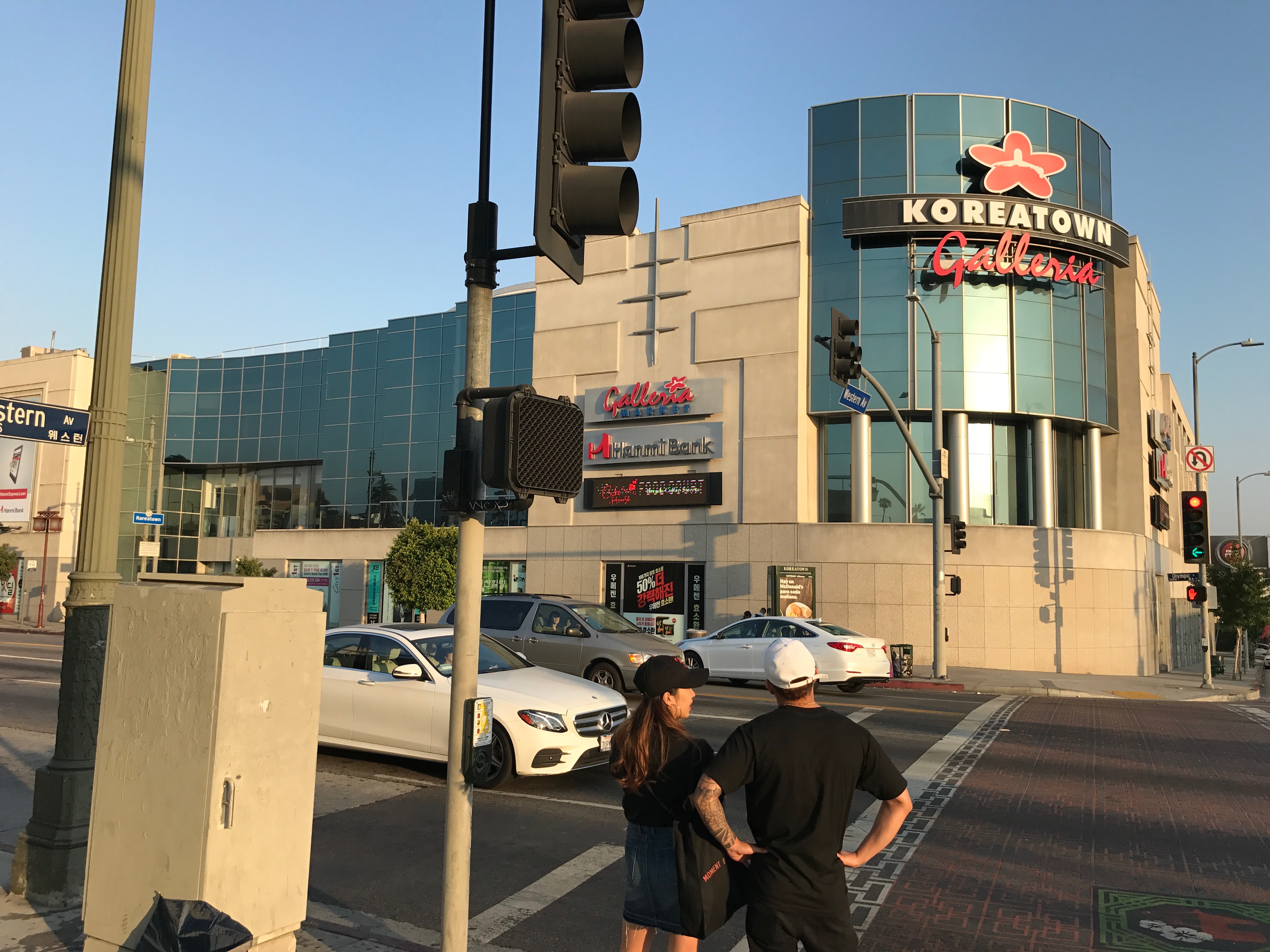
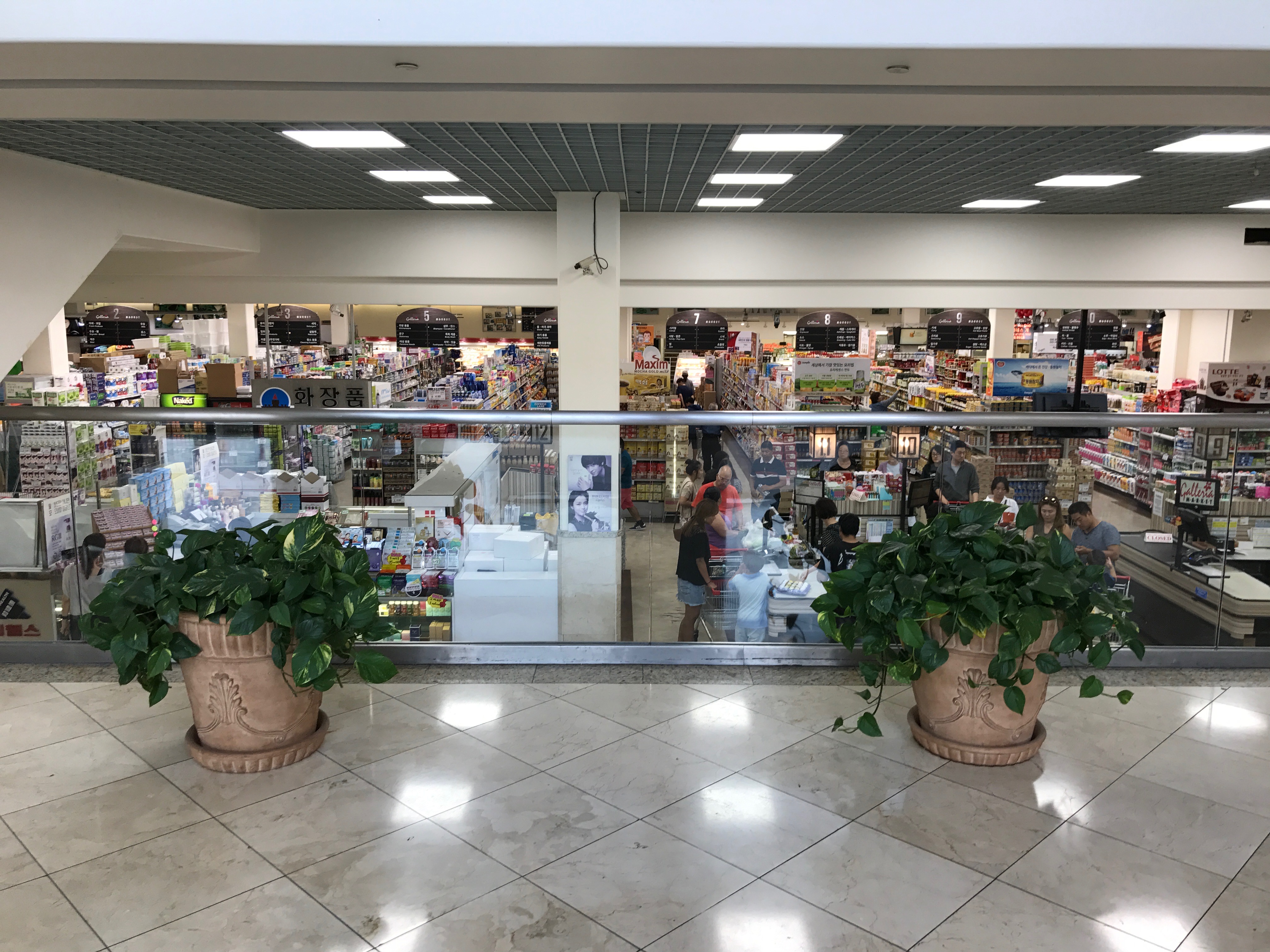
The last mall on our ramble was Koreatown Galleria, which opened in 2001. For some reason, its design resembles that of an airplane hangar and even the food court more resembles the sort you encounter in an airport than in a typical mall, Korean or otherwise. Like most Korean malls, its anchor is a market (not a big, box, department store chain outlet), in this case, Galleria Market. Many Korean markets — especially those located in suburban area’s such as Orange County‘s Little Seoul — almost pass for malls themselves, containing as they often do salons, food courts, banks, and other businesses in one shared space.
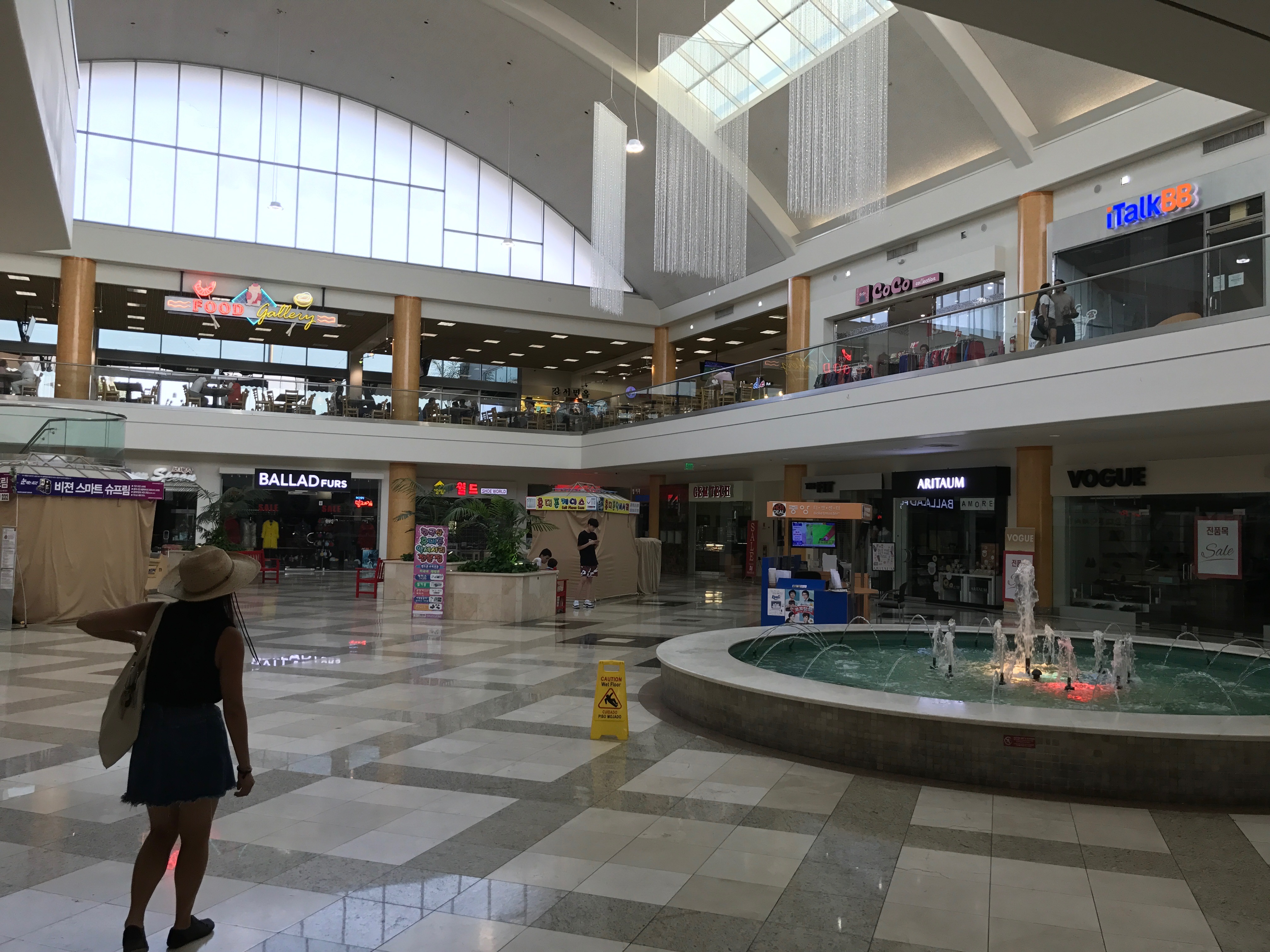

Perhaps because it was built around the end of the Mall Era, that the Koreatown Galleria is fairly small. By the time we arrived, most of the shops had either closed or were the process of doing so. The food court, or “Food Gallery,” was still full of diners, though, and I wondered whether or not there exist people who pledge their allegiance to rival Koreatown mall food courts. The answer, as proven by Chowhound, is of course there are.

I wanted coffee and Machiko pointed out Little Bean Cafe, which it should be noted is not in the food court. I got an iced Americano and she got a ginger tisane, which the menu categorized along with all the tisanes as, “Korean Tea.” I’d read, in researching tisanes, that they are sometimes referred to as “Korean Tea” but this was my first time seeing that in real life. Also, one of the flavors was jujube, which prior to visiting Korea, I’d only seen used to refer to a now-obscure brand of candy popular in the silent film era.
By this point, the sun was near the horizon and, assuming they have outlets and WiFi, we both thought it seemed like a place where one could spend a lot of time… but I suggested we move on because Metro’s 201 line, which connects my apartment to Koreatown, stops running at an absurdly early hour — the departure from Vermont & Wilshire happens at 19:56.

After leaving the Koreatown Galleria, we headed east down Olympic, in order to visit the site of Koreatown’s origins. It was there, at the intersection of Irolo and Olympic, that a recently arrived immigrant, Hi Duk Lee, purchased a market which he re-named Olympic Market. In 1975 he opened a Korean restaurant, Young Bin Kwan (aka VIP Palace), three blocks east. Lee purchased five blocks which he hoped to develop into a tourist-friendly enclave named “Korean Village.” Financial misfortune led to the abandonment of the Korean Village project and Lee spent the next decade living in China. He eventually returned to Los Angeles and opened a nursery, Echo Garden, in Echo Park (and now located in Eagle Rock). It seems an appropriate occupational choice for a man who also planted the seeds of what grew into the country’s preeminent Korean enclave.

Lee naturally advocated constructing buildings that were recognizably Korean looking. Even with a coat of orange paint and the addition of murals, that Oaxacan restaurant Guelaguetza was formerly the home of the Korean restaurant, Young Bin Kwan, is not especially surprising. In my neighborhood of Silver Lake, a Korean-looking wall surrounding a house on Tularosa Drive bears a sign which tellingly states “Hi Duk Lee.”
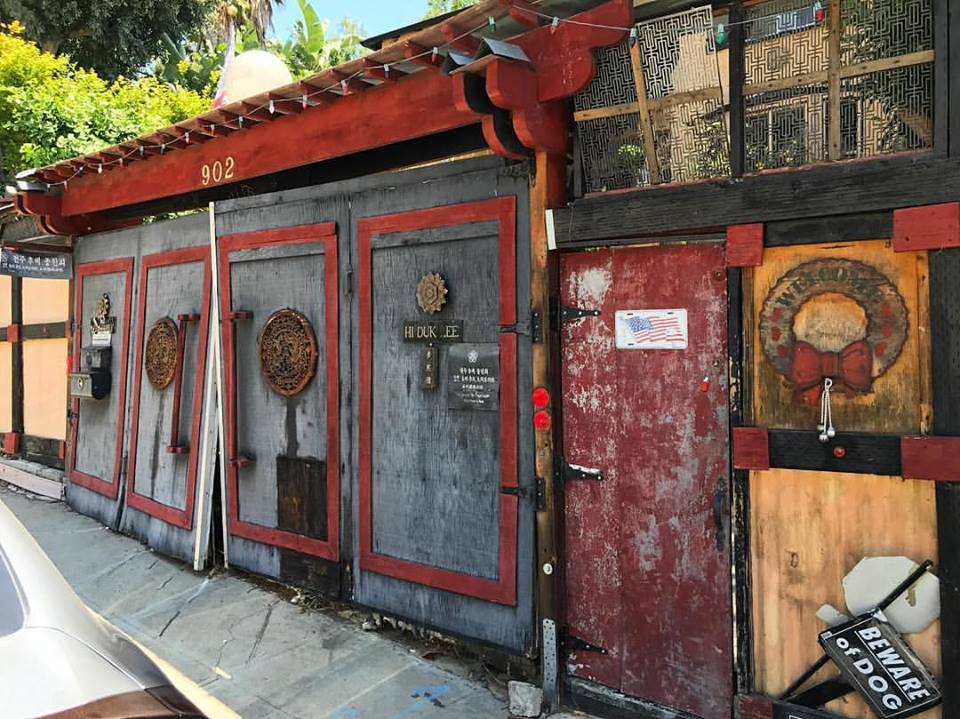
How “Korean” Koreatown looks is probably at least partly in the eye of the beholder. Many of the shopping centers and strip malls are topped with the iconic blue, tile roofs and there are pagoda-shaped “welcome to Koreatown” signs, Korean patterns in some of the crosswalks, and occasionally street signs are translated into Korean. On the former site of Olympic Market stands one such building, topped with a sign written only in Korean, stating 한옥 플라자, or “Korean Plaza.”But even if most of the buildings make no effort to resemble those of the Joseon Dynasty, I think that there’s still something recognizably Korean about the glass and steel structures more common to both Korean cities and Koreatown — even beyond their Hangul signage and whatever the nationality of their architects.
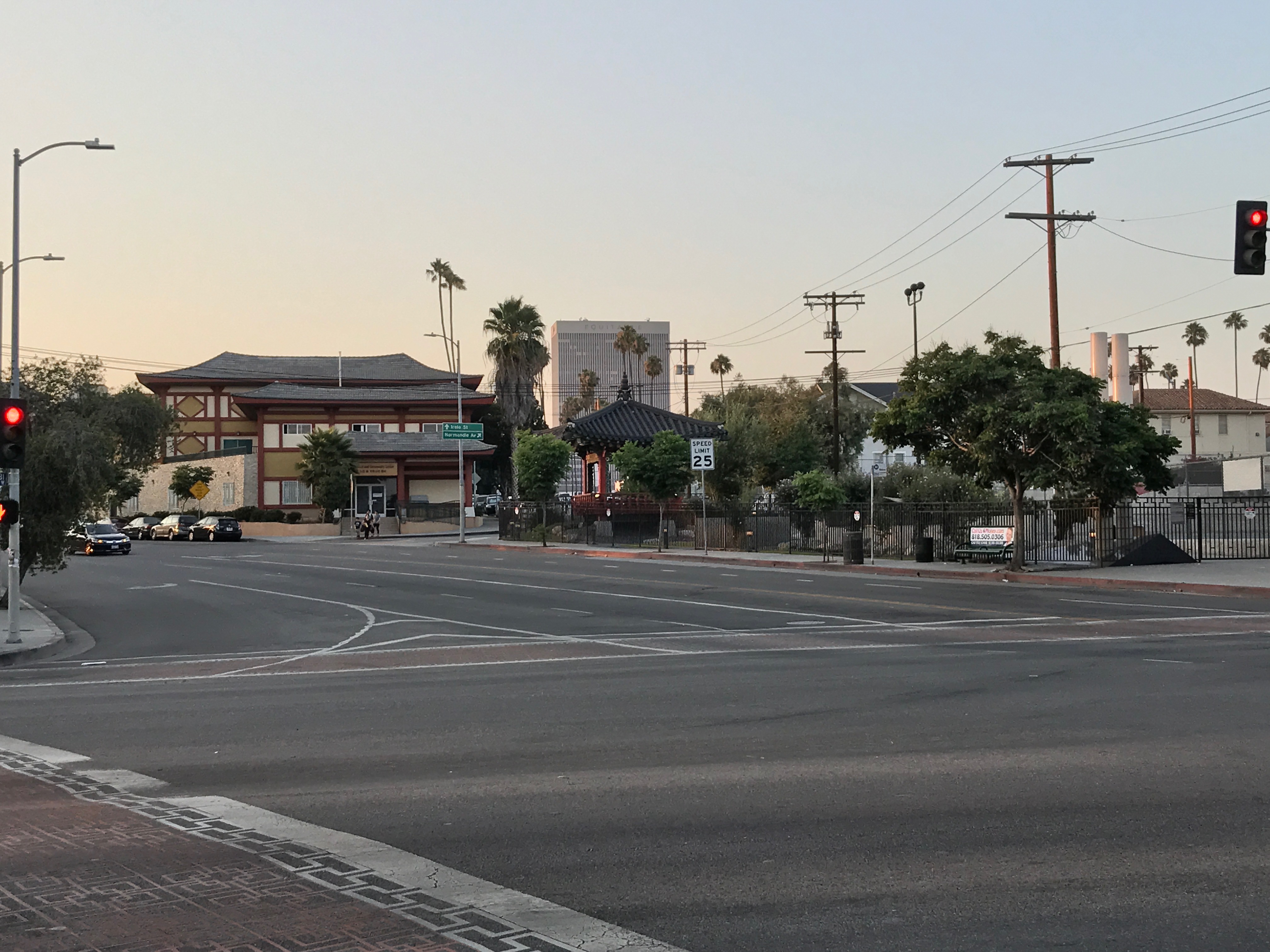
As we walked north on tree-lined Irolo, I began to feel like we’d entered another neighborhood — or a part of Koreatown distinct from the neighborhoods which in the past were more commonly referred to as Wilshire Center and the Olympic Corridor. How long before vibrant Koreatown expands and develops to a point where it’s divisible into its own Korean neighborhoods? My first thought was “North Koreatown” and “South Koreatown,” although, on examination, those names would surely convey an unintended and inaccurate meaning. The area around 8th and Irolo, though, definitely has a vibe which differs from that around Wilshire and Western. Hopefully, it will happen organically.
In a coincidental turn of events, a young Korean woman stopped us and asked for directions to Guelaguetza. After pointing her down the street, you know, to South Koreatown, we made our way back to the current western terminus of the Purple Line, Wilshire/Western Station — which is located beneath a shiny mixed-use high-rise where condominium-dwellers reside above several stories of businesses. It’s a sort of building you see a lot of in Korea, especially Busan’s Marine City. Little Marine City, anyone?

Eric Brightwell is an adventurer, essayist, rambler, explorer, cartographer, and guerrilla gardener who is always seeking paid writing, speaking, traveling, and art opportunities. He is not interested in generating advertorials, cranking out clickbait, or laboring away in a listicle mill “for exposure.”
Brightwell has written for Angels Walk LA, Amoeblog, Boom: A Journal of California, diaCRITICS, Hidden Los Angeles, and KCET Departures. His art has been featured by the American Institute of Architects, the Architecture & Design Museum, the Craft Contemporary, Form Follows Function, Los Angeles County Store, the book Sidewalking, Skid Row Housing Trust, and 1650 Gallery. Brightwell has been featured as subject in The Los Angeles Times, Huffington Post, Los Angeles Magazine, LAist, CurbedLA, Eastsider LA, Boing Boing, Los Angeles, I’m Yours, and on Notebook on Cities and Culture. He has been a guest speaker on KCRW‘s Which Way, LA?, at Emerson College, and the University of Southern California.
Brightwell is currently writing a book about Los Angeles and you can follow him on Ameba, Duolingo, Facebook, Goodreads, Instagram, Mubi, and Twitter.



An entertaining descriptive read with photos full of straight lines. Let’s not move the ugly structures up here to the High Desert! Lol!
LikeLiked by 1 person
What if we through in some early Streamline Moderne service stations and Googie coffee shops?
LikeLike
Also, congrats on making it to 10 years!!!!!!!!!!!!!!
LikeLiked by 1 person
Thank you!
LikeLike